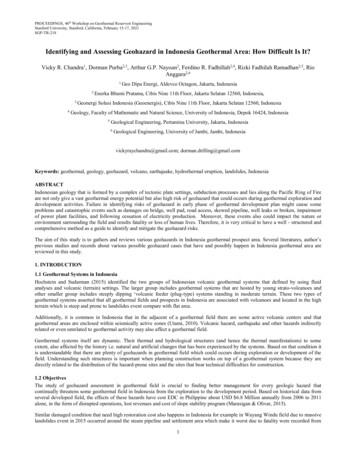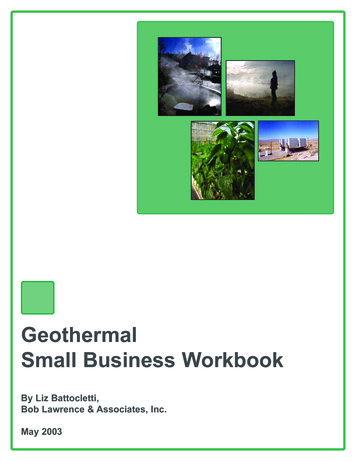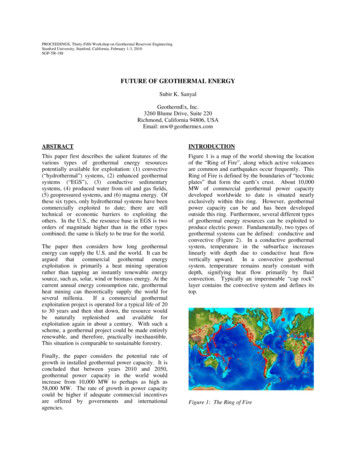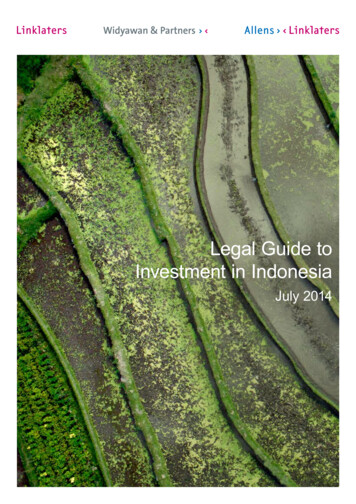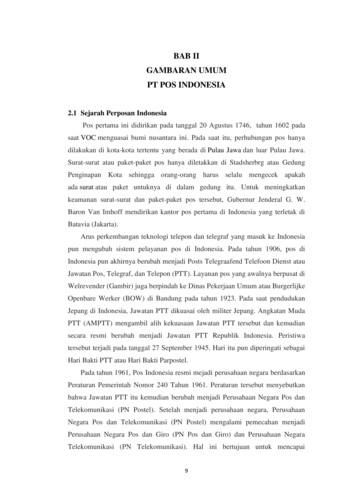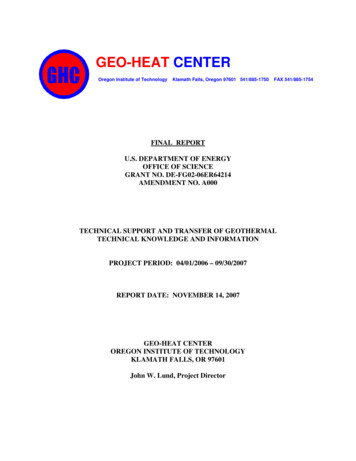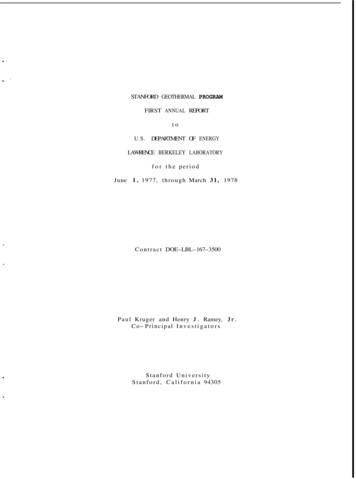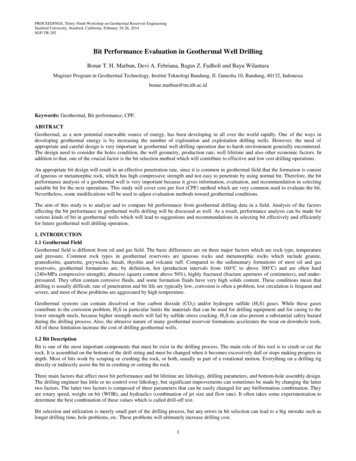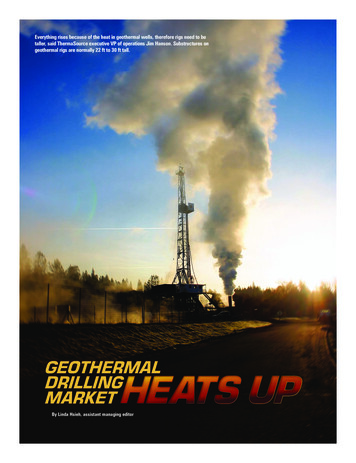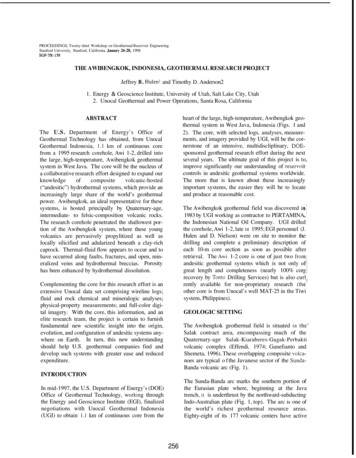
Transcription
PROCEEDINGS, Twenty-third Workshop on Geothermal Reservoir EngineeringStanford University, Stanford, California. January 26-28, 1998SGP-TR- 158THE AWIBENGKOK, INDONESIA, GEOTHERMAL RESEARCH PROJECTJeffrey B. HulenI and Timothy D. Anderson21. Energy & Geoscience Institute, University of Utah, Salt Lake City, Utah2. Unocal Geothermal and Power Operations, Santa Rosa, Californiaheart of the large, high-temperature, Awibengkok geothermal system in West Java, Indonesia (Figs. 1 and2). The core, with selected logs, analyses, measurements, and imagery provided by UGI, will be the cornerstone of an intensive, multidiscliplinary, DOEsponsored geothermal research effort during the nextseveral years. The ultimate goal of this project is to,improve significantly our understanding of reservoikcontrols in andesitic geothermal systems worldwide.The more that is known about these increasinglyimportant systems, the easier they will be to locateand produce at reasonable cost.ABSTRACTThe U.S. Department of Energy’s Office ofGeothermal Technology has obtained, from UnocalGeothermal Indonesia, 1.1 km of continuous corefrom a 1995 research corehole, Awi 1-2, drilled intothe large, high-temperature, Awibengkok geothermalsystem in West Java. The core will be the nucleus ofa collaborative research effort designed to expand c”) hydrothermal systems, which provide anincreasingly large share of the world’s geothermalpower. Awibengkok, an ideal representative for thesesystems, is hosted principally by Quaternary-age,intermediate- to felsic-composition volcanic rocks.The research corehole penetrated the shallowest portion of the Awibengkok system, where these youngvolcanics are pervasively propylitized as well aslocally silicified and adularized beneath a clay-richcaprock. Thermal-fluid flow appears to occur and tohave occurred along faults, fractures, and open, mineralized veins and hydrothermal breccias. Porosityhas been enhanced by hydrothermal dissolution.The Awibengkok geothermal field was discovered io’1983 by UGI working as contractor to PERTAMINAthe Indonesian National Oil Company. UGI drilledthe corehole, Awi 1-2, late in 1995; EGI personnel (J.Hulen and D. Nielson) were on site to monitor the:drilling and complete a preliminary description ofeach 10-m core section as soon as possible afterretrieval. The Awi 1-2 core is one of just two frofi,andesitic geothermal systems which is not only of1great length and completeness (nearly 100% corgrecovery by Tonto Drilling Services) but is also curlrently available for non-proprietary research (theother core is from Unocal’s well MAT-25 in the Tiwisystem, Philippines). ’Complementing the core for this research effort is anextensive Unocal data set comprising wireline logs;fluid and rock chemical and mineralogic analyses;physical-property measurements; and full-color digital imagery. With the core, this information, and anelite research team, the project is certain to furnishfundamental new scientific insight into the origin,evolution, and configuration of andesitic systems anywhere on Earth. In turn, this new understandingshould help U S . geothermal companies find anddevelop such systems with greater ease and reducedexpenditure.GEOLOGIC SETTINGThe Awibengkok geothermal field is situated in the’Salak contract area, encompassing much of theQuaternary-age Salak-Kiaraberes-Gagak-Perbaktivolcanic complex (Effendi, 1974; Ganefianto andShemeta, 1996). These overlapping composite volca.noes are typical o f the Javanese sector of the SundaBanda volcanic arc (Fig. 1).INTRODUCTIONThe Sunda-Banda arc marks the southern portion ofthe Eurasian plate where, beginning at the Javatrench, it is underthrust by the northward-subductingIndo-Australian plate (Fig. 1, top). The arc is one ofthe world’s richest geothermal resource areas.Eighty-eight of its 177 volcanic centers have activeIn mid-1997, the U.S. Department of Energy’s (DOE)Office of Geothermal Technology, working throughthe Energy and Geoscience Institute (EGI), finalizednegotiations with Unocal Geothermal Indonesia(UGI) to obtain 1.1 km of continuous core from the256
Indian OceanKilometersFigure 1. Maps of Java, Bali, and southermost Sumatra, Indonesia, showing (top) volcanoes with documentedHolocene eruptions (including hydrothermal eruptions) and (bottom) geothermal fields and prospects.Volcanoes from Simkin and Siebert, 1994. Geothermal sites synthesized from Radja, 1990; Effendi,1991; Ganda et al., 1992; and Rachman et al., 1995 (site numbers and locations differ slightly amongthese sources).257
n Non-producersI4R-3 Kawah RatuW0%%0””R-10I\alteration‘Y”& Producer2 Injection Well2.215-2Interpretedfield edge15.3‘- 4Power Plants14-4Figure 2. Well map of the Awibengkok geothermal field and Ratu geothermal area, showing’.location of corehole Awi 1-2. Modified slightly from Unocal et al., 1997.(LOOKING NORTH)A’r-2000b C O M M E R C I A L T H E R M A L - F L U I D ENTRYFigure 3. Highly generalized west-to-east cross section through the Awibengkok geothermalfield. Modified from Murray et al., 1995; and Unocal et al., 1997.258
intensely propylitized rocks dominated by the secondary-mineral assemblage epidote, chlorite, and calcite; adularia, quartz, pyrite, sericite “leucoxene”(sphene-anatase mixture), anhydrite, and wairakiteare also present in varying amounts and combinations.surface thermal features (solfataras, hot springs,fumaroles, mud pots, and heated ground), and severalsupport producing geothermal systems (Radja, 1990;Rachman et al., 1995).Large-scale geothermal power production inIndonesia commenced at the vapor-dominatedKamojang field (Fig. I , bottom) in 1983. As of late1997, Kamojang and the nearby, smaller but similarDarajat field were producing, respectively, 140 and 55MW of electrical power (David Rohrs, pers. comm.,1998). At 330 MW of installed electrical generatingcapacity, however, the Awibengkok field is currentlyIndonesia’s largest.The cored portion of Awi 1-2 penetrated the depthinterval 762-1830 m (Fig. 4). Beneath an upperandesitic lahar breccia, the hole encountered, insequence: a thin dacite ash-flow tuff; a thick zone ofdacite flow-dome (?) rocks (with prominent quartzphenocrysts); another thin andesitic lahar breccia; awholly altered andesitic tuff complex; and a relatively thinly bedded sequence of flow rocks, lahar breccias, and tuffs to total depth. There are many thinandesite and dacite porphyry intercepts in the corehole which conceivably could be subvolcanic intrusives rather than flow rocks, but a microdiorite porphyry at about 1700 m depth is of unambiguous intrusive origin. Hydrothermal breccias are common inthe core (Fig. 4), and include pebble dikes and jigsawpuzzle breccias cemented by black pyritic silica.Open veins with apertures as large as 2 cm occurthroughout the core below about 1100 m depth.Adjacent to and between these veins, irregular voidsup to several cm in diameter record prior hydrothermal dissolution.Awibengkok and the Ratu thermal area to the east(Fig. 2) are hosted principally by interstratified, intermediate- to felsic-composition, Quaternary-age flowand dome rocks, lahar breccias, and tuffs locallyinvaded by chemically similar subvolcanic andhypabyssal intrusive rocks. Of the four overlappingmajor volcanoes built of these products, only Salakhas erupted juvenile magmatic material in Holocenetime, having reportedly produced a small-volumepyroclastic flow in 1699 AD (Simkin and Siebert,1994; L. Siebert, pers. comm., 1998). OtherHolocene eruptions from Salak (including Ratu) andfrom Kiaraberes-Gagak have been phreatic events,yielding localized aprons of unsorted lithic debris.TECHNICAL INFORMATION TOACCOMPANY THE COREThe Awibengkok field exploits a large but otherwisetypical, high-temperature, neutral-chloride, andesiticgeothermal system. Reservoir temperatures rangefrom 220 C to more than 300”C,and the produced fluids typically have a TDS content of about 1.3%(Ganefianto and Shimeta, 1996). Corehole Awi 1-2was drilled in the shallowest portion of the geothermal reservoir, a sort of “cupola”, where Murray et al.(1995) postulated there might have been a preexploitation gas cap (Fig. 3).An important asset to the Awi 1-2 research programwill be an extensive collection of wireline logs andanalytical data made available for the project by UGI.The logs, in digital format, include (1) total-countgamma; (2) spectral gamma; (3) injection temperature; (4) caliper; (5) vector magnetic intensity; (6)dual-induction; (7) SP; and (8) full-waveform soniclogs for the corehole and/or the adjacent sidetrackproduction well. The core was also analyzed at thewell site for porosity and density, and for total-countgamma ray intensity at 3294 pts along its full length.Continuous, digital, high-resolution color imagery ofthe slabbed core, to be distributed in CD-ROM format, will allow investigators to view selected intervals with ease.This cupola is somewhat unusual for the field in thatit locally encompasses the basal portion of a fieldwide argillic-phyllic alteration halo surrounding thereservoir proper (Ganefianto and Shemeta, 1996;Figs. 2 and 3). Within the halo, the volcanic rockshave been partially to near-completely altered tosmectite, mixed-layer illite/smectite, and chlorite,with subordinate calcite, quartz, pyrite, and localhematite. As typical for such alteration, the illite content of mixed-layer illitehmectite in general increaseswith increasing depth and temperature.Various analyses and measurements obtained for thecore by UGI and made available as background forthis investigation include: ( 1) porosity and permeability under ambient and overburden conditions; (2)magnetic susceptibility; (3) whole-rock silicate oxygen-isotope values; (4) mechanical properties ofThe bulk of the Awi geothermal reservoir is hosted by259
AWI 1-2ALTERATIONLITHOLOGYDEPTH(M),,ANDESITIC LAHAR BRECCIAARGlLLlCDAClTlC ASH-FLOW T U F F,DAClTlC FLOW-DOME ROCKS,1LAHAR BRECCIAS, AND T U F F S( E X C E P T AS NOTED)ARGILLIC- PHY L L l CWITH LOCALSI L I C I FI CAT10 NIIli te inte rlayersincreasing inmixed-layerillite/smectite\Intense silicificationCOMPLETEARGILLIC- PHYLLIC,ANDESITIC LAHAR BRECCIAANDESITIC T U F F //I//I/PROF L l T l CWITH LOCALAD U LA R I Z AT10 NAND SI L IC I F I CAT10 NANDESITIC L n r l A R BRECCIAS,FLOW ROCKS, AND T U F F S( E X C E P T AS NOTED)I- MicrodioritePorPhY rY* see Figure 3 FLUID ENTRIESFigure 4. Highly generalized lithologic and alteration columns for corehole Awi 1-2. Simplified and modified fromfield geologic log prepared in late 1995 by J. Hulen and D. Nielson. Fluid entries inferred from prominent local excursions on UGI injection-temperature-gradient log.260
with other rock and reservoir properties. For example, do certain alteration mineral assemblages andzoning sequences show a systematic relationship toactive thermal-fluid conduits? Are impermeablehydrothermal breccias differently altered than theirpermeable vuggy counterparts? Investigate the utilityof secondary-mineral zoning and parageneticsequences in mapping potentially productive fluidchannels.rocks; and ( 5 ) brine and gas compositions from flowtests of the corehole and an adjacent production well.These data will clearly enhance the value of collaborating investigators’ individual and collective researchefforts.SCIENTIFIC OBJECTIVESThe principal scientific and practical goals of thisinvestigation can be stated briefly as follows: (1)Through detailed study of the continuous Awi 1-2core and accompanying database, significantlyimprove understanding of reservoir controls in a largebut otherwise typical island-arc, andesitic, hydrothermal system. ( 2 ) Compare and contrast thenew information obtained from this study with corresponding data from other such systems, both local andglobal. (3) Present and publish results promptly sothat these systems can be found and developed in allparts of the world with greater efficiency and minimum cost.5 -- Reconstruct the hydrothermal history of the portion of the Awibengkok system penetrated by thecorehole. If possible, utilize this information to helppredict changes in reservoir characteristics with timeand progressive depletion.6 -- Measure multiple physical and mineralogic properties of the penetrated rocks, not only under ambientconditions but also under simulated reservoir pressures and temperatures. Examine the utility of thisinformation in constraining interpretations of surfaceand borehole-based geophysical surveys.SIGNIFICANCE OF EXPECTED RESULTSKey tasks leading to fulfillment of these goals includebut are not limited to the following: 1 -- Determinethe origins, measure and map the configurations, andestablish the interrelationships of fractures, breccias,dissolution cavities, vesicles, and other voids whichsingly or in combination serve as geothermal-fluidconduits or storage sites. Develop predictive concepts for the location, character, and quality of permeable zones in andesitic geothermal systems as aclass. Study the relative influence of regional vs localcontrols on development of these features. For example, to what extent are fractures and breccias formedin response to far-field stresses, and to what extent arethey products of local forces.The new information obtained from this investigationwill: (1) improve the odds of finding similar andesiticsystems anywhere in the world; (2) help reduce costsin exploiting those systems already secured, includingAwibengkok itself; and (3) help enable reservoir engineers to prolong the systems’ productive lives throughmore informed long-term development strategies.The work will also inevitably yield a detailed pictureof the system’s evolution since inception, especially:(1) the nature and timing of events specifically linkedto the creation or modification of porosity and permeability; and (2) fluid sources, volumes, pathways,chemical transformations, and thermal histories. Thisknowledge will be valuable not only in geothermalexploration and development, but also in the searchfor and mining of worldwide, volcanic-hosted,epithermal mineral deposits.2 -- Ascertain lithologic controls on the geothermalsystem’s key components (for example, caprock vsproductive reservoir; aquifers and aquicludes in thereservoir proper). In so doing, establish a detailedvolcanic stratigraphy which will be useful for threedimensional mapping of discordant potential fluidconduits such as fractures and pebble dikes.APPROACH3 -- Investigate the effects of igneous intrusions on thegeometry of the geothermal system and on the permeability-related compositions and textures of the reservoir rocks invaded by these plutons.The Awi 1-2 core arrived in late January 1998 atEGI’s Geothermal Sample Library, where it will beavailable for examination and judicious sampling bycollaborating investigators. To ensure proper archivalof the core and the data generated therefrom, sampling activities will be governed by a strict core protocol. For example, each researcher will be requestedto furnish raw data generated by his or her research4 -- Map in detail hydrothermal alteration mineralogyand zoning on a reservoir-wide and local scale.Critically examine this information for correlations26 1
the detailed geologic logging mentioned above; petrographic analysis; X-ray diffraction; X-ray fluorescence and other geochemical analytical techniques;stable-isotope geochemistry; electron-microbeamgeochemical analysis of individual minerals; claymineral geothermometry; 40Ar/39Ar incrementalheating age dating and thermal-history modeling;fluid-inclusion microthermometry and geochemicalanalysis (especially trapped gases); numerical geochemical modeling.project to EGI within a specified period followingsample acquisition. The core itself will be (technically, will have been when this paper is published) thefocus of a workshop in Salt Lake City, Utah, duringthe second quarter of 1998. A site-specific SciencePlan for the project will be debated and refined at thisgathering, and copies of the Plan will be distributed toall participants within two months of the workshop.Chief Scientist for the project will be J. Hulen of EGI.In order to maximize the project's scientific yield,Hulen will maintain close contact not only with theresearch team, but with key Unocal personnel mostfamiliar with Awibengkok, especially Unocal's ChiefDevelopment Geologist Glenn Melosh, SeniorGeologist Jim Stimac, and Research Coordinator TimAnderson. The Awi research plan as presently envisioned will be a modification and expansion of theone successfully applied on The Geysers CoringProject (e.g. Hulen et al., 1995), but tailored to thegeologic, geochemical, and hydrologic setting of theAwibengkok field.3 -- Refined characterization and measurement ofporosity and permeability at the scale of the core, utilizing an array of precise, modern, imaging and analytical methods.4 -- Monitoring of changes in permeability, porosity,and other rock properties of the core (for example,electrical and acoustic) at various simulated reservoirconditions. This information will be useful in forecasting reservoir behavior, for planning effectiveinjection strategies, and for predicting the responsesof various rock units and alteration assemblages during surface- and borehole-based geophysical surveys.Fundamental studies for the Awi 1-2 project will bethose which have proven value in the characterizationof high-temperature geothermal systems and epithermal mineral deposits. Some of the investigationsscheduled for completion are listed below. A moreexhaustive catalogue will have emerged from the Awiworkshop in Salt Lake City.SUMMARYThis outline of the Awibengkok research project, inaddition to announcing an unparalleled geothermalresearch opportunity, is also in effect the project'sabbreviated, preliminary Science Plan. The Plan willhave been expanded and refined at the Salt Lake Cityworkshop through the efforts of interested investigators from universities, national laboratories, governmental agencies, and other institutions. Componentresearch projects are envisioned to span 1-3 years.Research updates will be given to all interested partiesin semi-annual EGI reports, and in talks and discussions at the annual Stanford Workshop andGeothermal Resources Council Meeting. We will further distribute information electronically via theworld-wide web.I -- Detailed geologic logging of the core at a nominal scale of 1" 10 ft. This work will complement thevery preliminary logs prepared on site during drillingoperations, and will focus more closely on those features critical to the storage and transmission of thermal fluids in the subsurface -- fractures, faults, breccias, veins, vugs, dissolution cavities, vesicles, intergranular pores. Lithologic units will be scrutinized todetermine their roles as aquifers and hydrologic seals.A detailed stratigraphy will be established for comparison, ultimately, with the geologic sections penetrated elsewhere in the reservoir. The stratigraphicsection and its rock components will be comparedwith wireline logs so that similar units can be identified with greater confidence from log responsesalone. I1ACKNOWLEDGEMENTSDOE support for the Chief Scientist is being provided 1'by the Office of Geothermal Technology, ContractNo. DE-AC07-95ID 13274. We appreciate thoughtfulreviews by Glenn Melosh and David Sussman.Discussions with the following Unocal geoscientistsclarified the nature and geologic setting of the Awi I2 -- Studies of hydrothermal alteration mineralogyand zoning as well as vein mineralogy and paragenesis will provide detailed information for constrainingthe hydrothermal history of the Awibengkok system.Methods to be employed in this undertaking includeI262
Ganefianto, N., and Shemeta, J., 1996, Developmentstrategy for the Awibengkok geothermal field, WestJava, Indonesia: Indonesian Petroleum Association,25th Anniversary Convenl.ion, Proceedings, 1 1 p.system in the context of West Javan geology: NoviGanefianto, Brian Koenig, Glenn Melosh, IrawadiPrihaswan, David Rohrs, Birean Sagala, EiawaSantosa, Jim Stimac, and Fransiskus Sugiaman.Birean Sagala, with help from Ngadi, organized asuperb local workforce at the field to help transfer,mark, and box the core for shipment from Java to theUSA. Irawadi Prihaswan and his brother as well asFransiskus Sugiaman and Courtney Isselhardt graciously supplied certain hard-to-obtain geologic andprospect maps on short notice; we are grateful fortheir help. John Kohn, of Traffic International LAXin El Segundo, California, smoothly brokered theeight tons of Awi core through U.S. Customs (despitegalling bureaucratic hassles) and arranged for itstrucking to Salt Lake City. Special thanks are dueBrian Koenig, Unocal operations manager duringactual coring operations. Without his close attentionto every detail of the endeavor, we might not have thecore to work with at all.Hulen, J.B., Koenig, B.A., and Nielson, D.L., 1995,The Geysers Coring Project, Sonoma County,California, USA -- Summary and initial results:Florence, Italy, World Geothermal Congress,Proceedings, p. 1415- 1420.Murray, L.E., Rohrs, D.T., and Rossknicht, T.G.,1995, Resource evaluation and development strategy,Awibengkok field: Florence, Italy, World GeothermalCongress, Proceedings, p. 1525-1529.Rachman, A., Lubis, L.I., :Boedihardi,M., Suroto, andMulyono, A., 1995, Geothermal prospects inIndonesia -- Prospect status and development opportunity: Florence, Italy, W(3rld Geothermal Congress,Proceedings, p. 531-535.--Illustrations by Ron Wilson and Doug Jensen-Radja, V.T., 1990, Review of the status of geothermaldevelopment and operation in Indonesia, 1985-1990:Geothermal Resources Council, Transactions, v. 14,p. 127-145.REFERENCESEffendi, A.C., 1974, Geologic map of the Bogor quadrangle, Java: Geological Survey of Indonesia,Ministry of Mines, Scale 1 : 100,000Simkin, T., and Siebert, L., 1994, Volcanoes of theworld (2nd edition): Tucson, Arizona, GeosciencePress, in association with the Smithsonian Institution,349 p.Effendi, A.C., 1991, Peta sebaran lokasi lapanganpanasbumi di Indonesia (Map of localities [ofl geothermal fields in Indonesia): Volcanological Survey ofIndonesia, Directorate General [of] Geology andMineral Resources, Department of Mines and Energy,scale 1:6,000,000.Unocal Geothermal Indonesia, ERTAMINA, PLN,and Nusamba Geothermal, 1997, Gunung Salak geothermal project guidebook, 21p.Ganda, S., Sunaryo, D., Hantono, D., andTampubolon, T., 1992, Exploration progress of highenthalpy geothermal prospect[s] in Indonesia:Geothermal Resources Council, Transactions, v. 16,p. 83-88.263
and produce at reasonable cost. The Awibengkok geothermal field was discovered io' . the corehole, Awi 1-2, late in 1995; EGI personnel (J. Hulen and D. Nielson) were on site to monitor the: drilling and complete a preliminary description of . Well map of the Awibengkok geothermal field and Ratu geothermal area, showing'.


